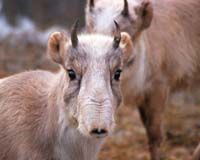| . |  |
. |
Washington (AFP) May 20, 2010 US researchers have developed the first self-replicating bacteria cell controlled by a synthetic genome, but denied Thursday they were playing God or seeking to recreate life in a test-tube. "This is the first synthetic cell that's been made," said lead researcher Craig Venter, unveiling the culmination of 15 years of research. "We call it synthetic because the cell is totally derived from a synthetic chromosome, made with four bottles of chemicals on a chemical synthesizer, starting with information in a computer." The method could be used to design bacteria specifically to help produce biofuels or to clean up environmental hazards, said the study carried out by the J. Craig Venter Institute, and published in the journal Science. Potential applications include producing algae to clean up carbon dioxide, one of the main greenhouse gases blamed for global warming, or making new clean energy hydrocarbons for refineries. Researchers also hope to work on techniques to speed up the production of vaccines and to make new food ingredients and chemical substances. "This becomes a very powerful tool for trying to design what we want biology to do," said Venter, co-author of the first sequencing of the human genome in 2000. But critics warned that he and his team were opening up a Pandora's Box by paving the way towards building artificial organisms that are still not properly understood. In an interview with the BBC, Venter defended himself from accusations that he was "playing God." "That's a term that comes up every time there is a new medical or scientific breakthrough associated with biology," he said. "It's been a goal of humanity from the earlier stages to try and control nature... that's how we got domesticated animals. "This is the next stage in our understanding, it is a baby step in our understanding of how life fundamentally works and maybe how we can get some new handles on trying to control these microbial systems to benefit humanity." The researchers synthesized the 1.08 million base pair genome of the bacterium Mycoplasma mycoides -- which commonly causes mastitis in goats -- created from four bottles of the chemicals which make up the components of DNA. They also added "watermarks" to the synthetic genome to distinguish it from a natural one. The watermarks included the names of 46 authors and scientists who worked on the project on the genome along with its own website address -- so that anyone who decodes it can send an email to the team. Three sets of quotations including "to live, to err, to fall, to triumph, to recreate life out of life" from Irish author James Joyce were also included. Venter told a press conference the team had started with a living cell, which had been transformed with the synthetic genome, adding the cell had gone through a "million steps of replication" and was now frozen in a freezer. "This is an important step we think, both scientifically and philosophically. It's certainly changed my views of the definitions of life and how life works," he added in a statement. Throughout the research, the team had engaged in discussions about the ethical implications of their work, he stressed. But Canadian international technology watchdog ETC Group warned against further such research. The synthetic cell "is not a one-stop shop for all our societal woes," said the group's director Pat Mooney. "It is much more likely to cause a whole new set of problems governments and society are ill-prepared to address." Venter's team announced in 2008 that it had chemically synthesized a bacterial genome, but it was unable to activate that genome in a cell at that time. Now the team had managed to "boot up" the synthetic genome to create the first cell controlled by a synthetic genome. But Jim Thomas from the ETC Group warned: "Synthetic biology is a high-risk, profit-driven field, building organisms out of parts that are still poorly understood. "We know that lab-created life forms can escape, become biological weapons and that their use threatens existing natural biodiversity." Dismissing the danger of bio-terrorism, Venter added to the BBC: "The technology is not for sale, the cells are not for sale. We are trying to use this technology to advance vaccine protection, we are trying to use it to advance the basic understanding of cellular life."
Share This Article With Planet Earth
Related Links Darwin Today At TerraDaily.com
 Mystery disease kills rare Kazakh antelopes
Mystery disease kills rare Kazakh antelopesAlmaty (AFP) May 20, 2010 More than 200 female saiga antelopes have died in Kazakhstan from an unknown disease, further threatening a species already at risk of extinction from poaching and habitat loss, officials said Thursday. Kazakh authorities have launched an inquiry to find the cause of the deaths of the saiga, which are listed as critically endgangered by the WWF. No other animal species in the area appeared t ... read more |
|
| The content herein, unless otherwise known to be public domain, are Copyright 1995-2010 - SpaceDaily. AFP and UPI Wire Stories are copyright Agence France-Presse and United Press International. ESA Portal Reports are copyright European Space Agency. All NASA sourced material is public domain. Additional copyrights may apply in whole or part to other bona fide parties. Advertising does not imply endorsement,agreement or approval of any opinions, statements or information provided by SpaceDaily on any Web page published or hosted by SpaceDaily. Privacy Statement |